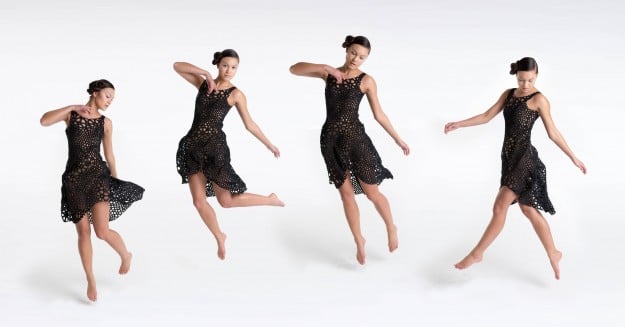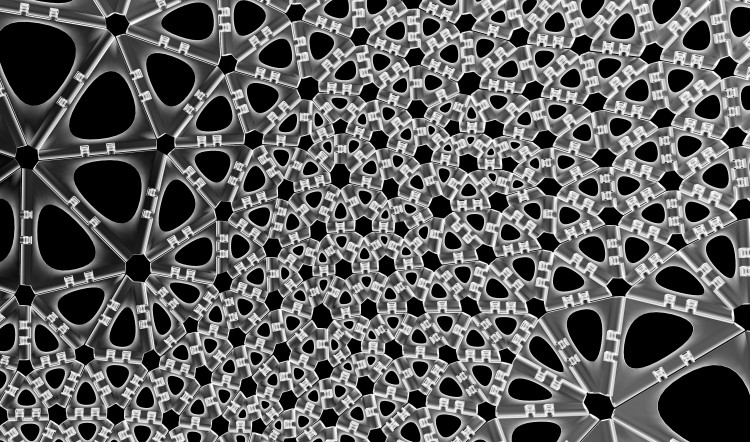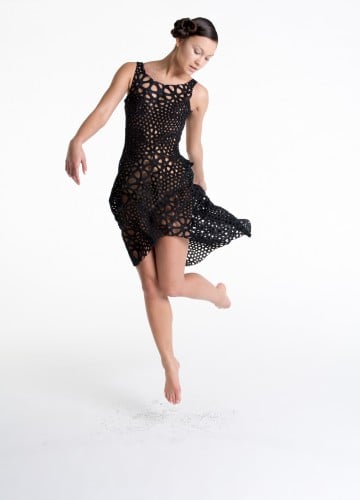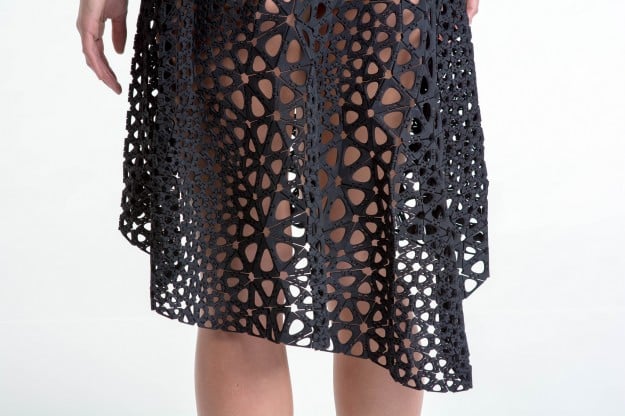
Today we are excited to unveil an amazing dress designed by Nervous System and 3D printed at our New York City factory. Using Kinematics – Nervous System’s 4D printing system that creates complex, foldable forms composed of modules – designers Jessica Rosenkrantz and Jesse Louis-Rosenberg created a completely wearable dress that prints in one single folded piece. It is made of thousands of panels connected by hinge joints and fluidly folds and conforms to the body as it is worn. Both the dress and Kinematics software have been acquired by the Museum of Modern Art for their permanent collection.
We’ve been working closely with Nervous System since 2009. They have been instrumental in showing the world the potential of 3D printing with their beautiful designs, and in helping us push the limits of our production capabilities and design guidelines. This dress definitely pushes the limits of what’s possible today. Given the file size and complexity, our 3D printing engineers worked with Jessica and Jesse to plan the build and closely check for printability before it went into production. The dress, while folded, is still a relatively large print and required a longer build time than our normal production process (44 hours!)…so we really only had one shot.
Our CEO Pete likes to say, shoot for the stars and you’ll reach the moon. In this case, we definitely reached the stars. Congrats to Jessica and Jesse. You guys have thrown down the gauntlet in what’s possible with 3D printing.

Kinematics Dress in motion. Image courtesy of Nervous System
We spoke with Jessica to hear more about the inspiration behind this dress and what she thinks the future of 3D printed fashion is…
How did the Kinematics Dress come about?
We first prototyped the idea for Kinematics on our Makerbot as a way to print something flat that could become three dimensional and wearable. We loved the materiality and movement of the hinged triangular components. Our first thought was that it would be amazing to produce something larger, like an entire dress, with this system on our little desktop printer. We quickly realized that making an entire dress out of tons unique 8” panels that would have to be flattened for printing and then assembled was crazy. There would be more work in the design process to panelize the dress and lots of manual labor to put it together. So we flipped the idea on its head. Instead of using the flexibility of the design to make something three dimensional that is produced flat, we simulate the movement in the computer to take something very large and 3D and make it flatter and more compact, so it can be 3D printed in one piece.
What was your inspiration?
This project really started from the limitations and opportunities of 3D printing. We were thinking about how we could harness the ability of 3D printers to make interlocking parts and very complex structures to create customized wearables.
In general, all our work is inspired by how patterns and forms emerge in nature. We take a systems approach to design. We don’t craft individual objects; instead, we create architectures for growing, sculpting or generating whole families of designs. For this project, we were more interested in designing a process and material than a garment.
In terms of other garments, we were definitely influenced by Janne Kyttanen and Jiri Evenhuis’s 3D printed chainmail dress. It set the standard for 3D printed garments not only by being the first but also by being one of the only ones that appears wearable and textile-like in its construction. If we were going to create a dress it was certainly going to a durable, comfortable, wearable piece. We were also inspired by the work of Issey Miyake, which often explores folding and structure in fashion.

An x-ray view rendering showing the hinges which structure a Kinematics design. Image courtesy of Nervous System
What are the benefits of the Kinematics approach versus traditional modeling?
Kinematics represents a new approach to manufacturing, which tightly integrates design, simulation, and digital fabrication to create complex, customized products. Our approach is completely different from traditional modeling and CAD software. The whole system is built up around the logic of a mechanism, in this case a hinge, which has been optimized for 3D printing and whose behavior we can simulate. Users interact with kinematics at a high level through an online design tool that lets them sculpt clothing shapes and “paint on” density and styles. Meanwhile, in the background the system is taking care of generating and connecting together all the geometry with our hinge mechanism. At the end of the design process, we have a 3D-printable piece of clothing made of thousands of panels interconnected by hinges. Rather than just ending up with big heavy file containing a bunch of “dumb” geometry, we end up with a smart structure that we understand as rigid panels connected by hinges. Because we understand the behavior of the geometry, we can use simulation to compress it down for efficient 3D printing.

Kinematics Dress. Image courtesy of Nervous System
What do you see for the future of 3D printing in clothing and fabrics?
We are particularly intrigued by how 3D printing applies to clothing in two areas: new meta-fabrics and customization.
Additive manufacturing has to ability to create very complex structures. In the world of clothing and fabrics, this is particularly intriguing because we are already talking about constructed materials. Fabrics produced from fibers that are aggregated and connected to create cloth with certain properties. For instance, knit cotton has stretch and woven cotton does not. Typically these material properties are constant throughout a whole piece of fabric. With 3D printing, we can start to create really weird fabric-like assemblages or mashups. We can print a textiles with gradations of material properties like stretch, flex, warmth, color, etc.
3D printing also favors the production of hyper-customized, one of a kind goods. We will see more apps like Kinematics that create custom-fit clothing and accessories from body data.
How does this fit into your broader collection?
Nervous System’s goal is to use computation and new fabrication techniques to make products that push the boundaries of what is possible. Most of our work starts with an inspiration from nature that eventually is translated into some sort of digitally fabricated, customized product. In this project, we actually started on the other end, being inspired by the technology itself and ultimately creating our own material system and form generating process.
How did MoMA get involved?
We met Paula Antonelli, the Senior Curator of Architecture & Design of the Museum of Modern Art, at an event this year where were demoing an early version of Kinematics Cloth app and displaying our Kinematics Bodice. She expressed interest in acquiring a Kinematics Dress for the MoMA collection… the only problem was we hadn’t made one yet. There were actually a number of design and technological hurdles we had to overcome before we could make a full dress. Even up to the last moment, just days before they needed it, we weren’t sure we would be able to deliver their final piece.
What’s next for Kinematics?
There are a lot of possible directions for Kinematics including new products, improved software and incorporating different mechanisms and structures. We’re doing more material experiments to explore how different types of connections can lead to different fabric behaviors. There are also still many improvements we can make to our folding algorithm to increase speed, accuracy and generality for other shapes. Another avenue we’d like to explore is creating a locking joint that would allow us to print a folded object that would snap into a rigid configuration when unfolded.




Very nice black dress, i like it, the hollow out design is very chic in these years, and will be in fashion in 2015. http://www.aiven.co.uk/
Very impressive. The cost, however, at this point anyway, would make this a prohibitive article to buy. But there is always someone who will! It’s good to see 3D printing design limitations being pushed.
Very well written article. That black dress is simply superb. Loved this post, very impressive.
I appreciate the math-ey design but it’s application seems over-hyped. I mean, hasn’t fabric been flowing with the body for thousands of years, with a lot more comfort? I understand that for 3D printing to gain public approval, a certain amount of shenanigans must take place, but why make something so non-useful and promote it’s physical characteristics as useful? Especially when considering the cost of production and lack of comfort!! I guess it defines / promotes a market that has nothing to do with usefulness and everything to do with temporary appearances. And for shapeways, that makes sense, in a business-kind-of-way.
Its a first step in the direction of enabling people to design their own clothes that can be fabricated without labor and without waste. Fabric itself is technology and has gotten far cheaper and more comfortable over a long period of time. Digital fabrication suggests new ways of making fabric. It can’t compete with weaving and knitting yet. But the ability to make things without assembly and fully customized is very promising.
1) If someone (Shapeways or anyone else) develops software that can take any computer simulated 3D surface, automatically turn it into a flexible jointed “fabric”, and fold it up for printing – that opens up entire new FAMILIES of products for the 3D printing industry. Clothing, hats, bags and purses, shoes, upholstery, etc.
2) Comfort depends on printing material, texturing, component resolution, and especially undergarments! Frankly I’ve worn clothes in the past that were much more uncomfortable than that dress looks. With camisole and leggings underneath, there’s no real reason why it would be less comfortable than any other dress.
3) Clothing that is *literally recyclable*.
4) Could be very useful technology for products like protective garments.
5) Don’t judge cost of production (or usefulness, or comfort) by the first prototype of an initial concept. Once 3D printers are common in homes, the cost to the user will be almost nil. Imagine someone downloading a garment design in the evening, setting it to print for the morning, wearing it during the day, and dumping it in the recycling unit at the end of the day, to reuse the plastic for the next printed object.
Not to mention, the more everyday objects like this that 3D printers can be used for, the more demand there will be for home units, and the faster the prices of printers will go down.
I saw this recently on http://www.design-milk.com , what a sensational piece of work! Fashion has always been about exploring the possibilities of new materials and new ways of putting things together. Something this material has that traditional fabrics does not is the lovely sound it makes as the wearer moves and jumps around.
I would love to see the hinge mechanism up close (from a design point of view) if that was possible.
very impressive ..it’s AMAZING …..
thanks